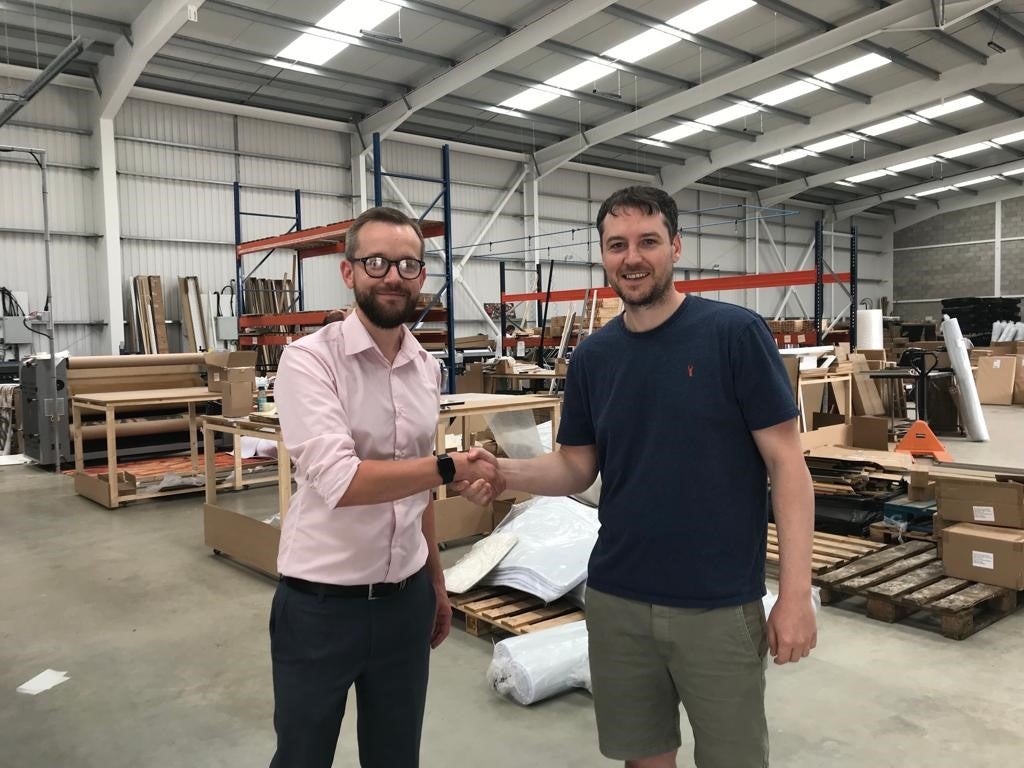Technological and
economic change means the printing industry offers plentiful
opportunities for those players who rapidly adapt to the new
environment. Vicky Meek reports.

The past decade has seen
technological shifts that are starting not only to revolutionise
the way printed material is produced, but also alter the media
through which people consume information, such as newspapers,
advertising and marketing flyers. The effect of this is being felt
by printers across the developed world.
Another factor impacting the
printing industry has been the financial downturn. Printers are
particularly susceptible to changes in the economic environment
because of their reliance, in many cases, on marketing spend –
flyers don’t get ordered and advertising gets pulled when companies
are worried about survival. That clearly dampens printers’ appetite
for capital expenditure.
‘Wait and see’
attitude
How well do you really know your competitors?
Access the most comprehensive Company Profiles on the market, powered by GlobalData. Save hours of research. Gain competitive edge.

Thank you!
Your download email will arrive shortly
Not ready to buy yet? Download a free sample
We are confident about the unique quality of our Company Profiles. However, we want you to make the most beneficial decision for your business, so we offer a free sample that you can download by submitting the below form
By GlobalData“Print tends to react badly
to negative economic news,” says Steve Price, director at brokers
Ilsley Finance.
“If there is nervousness in
the market generally, printers in my experience tend to adopt a
‘wait and see’ attitude and I have seen more of this over the last
12 months.
“Spending on new equipment
has seemingly quietened down and in general my customers have been
buying smaller or second-hand equipment. Anything above £250,000
[€283,278] is relatively quiet.”
“There is a lot of caution on
the market,” adds Ian Davies of brokers UCF Print Finance. “They
want to see what happens with interest rates and they want to see a
settled economic environment and so they are putting off
investment, particularly for big ticket items such as printing
presses.
“They are just not confident
enough to spend.”
Players in the sector are
therefore making do with what they have.
 “Some are
“Some are
taking the view that if a piece of equipment has worked fine for
the last five years, then it will work for another one or two,”
says Price.
While this may be a workable
strategy over the short-term – and printing presses, as assets with
long lives, are generally more suitable for contract extensions –
the changes in the market mean that printers will have to think
more about investment for the future as economic conditions
improve.
The internet has also
impacted the printing industry during recent years.
In 2010, for example, the
spend on online advertising in the UK hit record highs of over £4bn
and it had a 25% market share of advertising budgets, up from 23%
in 2009, according to a study by PricewaterhouseCoopers and the
Internet Advertising Bureau.
This, together with the move
towards electronic screen advertising, affects demand for printed
outdoor advertising.
At the same time, print
media, such as local newspapers, have suffered from a drop in
revenues from advertising and many have either closed or migrated
online themselves.
“In the publishing market, we
have seen a partial substitution of printed products by electronic
media,” says Stephan Knuppertz, head of financial services at
German-headquartered manufacturer Heidelberger Druckmaschinen
(Heidelberg).
“The publishing and newspaper
industry has to find its role in this new environment and has to
explore the opportunities that new media is offering.”
New media
opportunities
Knuppertz adds that, as a
result of the downturn, Heidelberg has seen the greatest fall in
demand from the publishing market, with sales of web offset
machines down.
The closure of printers is
also linked with increasingly efficient equipment.
“There was an over-supply in
the market,” says Paul Holohan, CEO of print industry corporate
finance adviser Richmond Capital Partners, which has just launched
a finance-raising division, Contour Business Finance.
“That was spawned by
technical developments and the easy finance that was available
pre-crisis. That caused prices to drop and affected gross
margins.”
“Ten years ago, machinery
could handle 10,000 sheets an hour; now that figure is up to
16,000,” adds Davies.
“Make-ready times have also
reduced and that has taken capacity out of the market. This is
capacity that won’t come back and so I know of several printers
that are talking to each other about merging or sharing equipment.
They can reduce staff by up to 50% and operate out of one factory
rather than two or more.”
Fewer printers in business
and increasing co-operation between those that have survived
clearly have some impact on the demand for new equipment and
therefore the leasing business. While there is a need to invest in
new machinery to stay ahead, that spend has yet to
materialise.
“There has been a large
reduction in investment by printers so there is a backlog of capex
that will need to come through at some point,” says Claus
Henneberger, head of transport and industrial equipment in the
sales and marketing department at SG Equipment Finance, which has a
worldwide presence in the print leasing industry.
“There has been a downturn in
investment in the order of 40% compared to 2008 levels. The last
two quarters have seen a pick-up in new equipment sales, but I
don’t expect a major breakthrough in this until 2012,” Henneberger
added.
Move to digital
machines
There has also been a move
towards digital machines and this has been a double-edged sword for
both the print industry and those providing finance to
it.
Traditionally, printers have
used large sheet-fed off-set machines to produce their material,
which are suitable for large volumes of printing. However, the
arrival of digital kit has made it more efficient and economical to
produce lower volumes than previously.
While this has been a
disadvantage for those unable to invest in the new equipment, for
others, it’s an opportunity.
“The quality of digital
printing has improved dramatically over the last ten years,” says
Paul Coggins, managing director of Print Finance, which was
recently acquired by Five Arrows Leasing Group.
“Printers are now buying
digital machines to complement their existing lithographic presses.
This equipment is cheaper and can free up the litho presses for
other work. It also enables printers to have a broader offering –
they can do long and short-run jobs.”
Given these factors, Coggins
says that while demand for litho presses has decreased over the
last couple of years, a lot of the finance he is arranging is for
digital equipment.
Manufacturers have been keen
to take advantage of the opportunity, too.
“The move towards digital has
had an impact on the manufacturers and the structure of the
industry,” explains Henneberger.
“For example, we are seeing
the manufacturers of offset printing machines tie up with the
manufacturers of digital printing equipment. The offset
manufacturers are looking to extend their portfolios to cover
digital equipment and address new customers.
“Companies that have
traditionally used just offset machines are also likely to buy one
or two digital machines to add to their printing
capabilities.”
Kodak and Konica have
recently announced a global distribution agreement and Heidelberg
and printing provider Ricoh have also teamed up in what Knuppertz
describes as “a combined sales strategy to offer a technical
solution to customers to cover all needs and demands of the
short-run colour and individualised printing market”.
Although Knuppertz sees the
traditional technology as remaining dominant for years to come,
there is plenty of scope for growth in digital
equipment.
“Digital has been on the
market for some time,” he says. “But it has not yet reached a
critical mass. We see double-digit growth figures, albeit from a
small market share of around 10%.
“It will continue to grow and
that is why we have agreed to partner with Ricoh.”
There are also signs of
growth in web to print, a business model that takes orders via the
internet.
“Using web to print, printers
are collecting different jobs and combining them on printing forms
to increase productivity,” explains Knuppertz. “Those established
in this segment are witnessing a fast increase in turnover and
profit.”
Overall, the changes in the
industry are separating the winners from the losers, and while
lessors may see a downturn in business in some areas and regions,
there are still plenty of opportunities to write new
business.
According to Henneberger, the
worldwide print market for asset purchases was between €4.5bn and
€5.5bn in 2010 and, in 2011, the sheet-fed offset market, which is
where SG Equipment Finance focuses, is set to be worth around
€3.4bn globally in the near future.
The demand for finance from
the print industry is one of the reasons Richmond Capital Partners
established Contour Business Finance. Furthermore, the
attractiveness of the margins available on business in this area is
partially behind Five Arrows’ acquisition of Print
Finance.
Margins have
improved
“We were in print back in the
late 1980s,” says Five Arrows managing director Sam Geneen. “But
the margins got squeezed and the returns that could be generated
were not sufficient for the risk taken.
“Now, however, many funders
have pulled out, so margins have improved.”
For lessors, the challenge
will be adapting to the new environment. Where previously, business
was written at the high end over longer terms, newer equipment,
such as digital, tends to be lower value, higher volume business
with shorter contracts.
“There will be more deals to
be done,” says Geneen. “I don’t know if we will be writing more in
absolute terms, but we will be doing more, smaller
deals.”
The other issue lessors will
have to become comfortable with is residual values and risk on
newer equipment. In the past, this is an area that some lessors
have struggled with.
“In the litho market, there
has historically been a number of dealers that would buy the
equipment from you,” says Coggins.
“There is an established
secondary market. For digital, this is less the case because the
market is not mature enough. There is also the issue that the
technology is evolving fast and so the equipment becomes obsolete
more quickly.”
However, some believe this
has changed.
“The digital part of the
market gains a mixed response from financiers because many assume
that the kit will become obsolete within a couple of years,” says
Price.
“In fact, the residuals on
digital offset in particular are pretty good: a machine that may
have cost £160,000 new can still be sold for around £90,000 five
years on.”
This is because the
infrastructure necessary to develop a secondary market is now in
place, says Davies.
“Historically, digital
residuals were very poor,” he says.
Davies notes: “When they
first came out, people were unable to buy on the secondary market
because there were no dealers that could refurbish the
machines.
“Unlike traditional
equipment, where it was easy to spot broken components and replace
them, buyers wouldn’t look at them because they couldn’t tell if
the equipment was working or not.
“Now, the resellers are in
place and they can refurbish machines. As a result, there is a
healthy market and actually, quite a lot of demand for second-hand
digital equipment.
“We recently sold a
two-year-old machine from a deal that went wrong. It was originally
worth £39,000 and we sold it for £14,000, which is a sensible
price.”
Davies adds that the current
climate is helping the secondary market.
“Some printers can’t afford a
£150,000 machine, even though it could make them more efficient,”
says Davies. “But if they can get a second-hand machine for £90,000
they will go for that.”
Printers are facing
significant headwinds, but there are bright spots that should
translate into opportunities for lessors. Advertising and marketing
budgets will increase as the economy stabilises further and, as
Knuppertz points out, there is greater demand for higher quality
output in this area “adding special effects and value-added
finishing”, which will require equipment upgrades.
There is also still strong
demand for printing from the packaging market in areas such as food
and technology – and again these are trending towards greater
sophistication.
Coggins says: “There is a lot of life yet in the printing
industry.”







